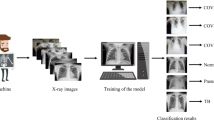Abstract
In recent years, many papers and models have been developed to study the classification of X-ray images of lung diseases. The use of transfer learning, which allows using already trained network models for new problems, could allow for better results in the COVID-19 disease classification problem. However, at the beginning of the pandemic, there were not very large databases of SARS-CoV-2 positive patient images on which a network could perform learning. A solution to this problem could be a Generative Adversarial Network (GAN) algorithm to create new synthetic data indistinguishable from the real data using the available data set. It would allow training a network capable of performing classification with greater accuracy on a larger and more diverse number of training data. Obtaining such a tool could allow for more efficient research on how to solve the global COVID-19 pandemic problem. The research presented in this paper aims to investigate the impact of using a Generative Adversarial Network for COVID-19-related imaging diagnostics in the classification problem using transfer learning.
Access this chapter
Tax calculation will be finalised at checkout
Purchases are for personal use only
Similar content being viewed by others
References
Aggarwal, A., Mittal, M., Battineni, G.: Generative adversarial network: an overview of theory and applications. Int. J. Inf. Manag. Data Insights 1(1), 100004 (2021). https://doi.org/10.1016/j.jjimei.2020.100004. ISSN 2667-0968
Brownlee, J.: How to develop a conditional GAN (CGAN) from scratch. https://www.machinelearningmastery.com/how-to-develop-a-conditional-generative-adversarial-network-from-scratch/ (2021)
Cleverley, J., Piper, J., Jones, M.M.: The role of chest radiography in confirming covid-19 pneumonia. BMJ 370 (2020). https://www.bmj.com/content/370/bmj.m2426https://doi.org/10.1136/bmj.m2426
Cyganek, B., et al.: A survey of big data issues in electronic health record analysis. Appl. Artif. Intell. 30(6), 497–520 (2016). https://doi.org/10.1080/08839514.2016.1193714
Deng, J., Dong, W., Socher, R., Li, L.J., Li, K., Fei-Fei, L.: ImageNet: a large-scale hierarchical image database. In: 2009 IEEE Conference on Computer Vision and Pattern Recognition, pp. 248–255 (2009). https://doi.org/10.1109/CVPR.2009.5206848
Goodfellow, I.J., et al.: Generative adversarial nets. In: Proceedings of the 27th International Conference on Neural Information Processing Systems, Vol. 2, pp. 2672–2680 NIPS 2014. MIT Press, Cambridge, MA, USA (2014)
Hong, Y., Hwang, U., Yoo, J., Yoon, S.: How generative adversarial networks and their variants work. ACM Comput. Surv. 52(1), 1–43 (2020). https://doi.org/10.1145/3301282
Karras, T., Aila, T., Laine, S., Lehtinen, J.: Progressive growing of GANs for improved quality, stability, and variation. CoRR arXiv: abs/1710.10196 (2017)
Krawczyk, B.: Learning from imbalanced data: open challenges and future directions. Prog. Artif. Intell. 5(4), 221–232 (2016)
Langr, J., Bok, V.: GANs in Action: deep learning with generative adversarial networks. Manning (2019). https://www.books.google.pl/books?id=HojvugEACAAJ
Mirza, M., Osindero, S.: Conditional generative adversarial nets (2014). http://arxiv.org/abs/1411.1784
Rahman, T.: COVID-19 radiography database. https://www.kaggle.com/tawsifurrahman/covid19-radiography-database (2021)
Sharma, S.: Activation functions in neural networks. https://www.towardsdatascience.com/activation-functions-neural-networks-1cbd9f8d91d6 (2021)
Shorten, C., Khoshgoftaar, T.M.: A survey on image data augmentation for deep learning. J. Big Data 6, 60 (2019). https://doi.org/10.1186/s40537-019-0197-0
Simonyan, K., Zisserman, A.: Very deep convolutional networks for large-scale image recognition (2014). http://arxiv.org/abs/1409.1556
Szczepaniak, P.S., Tadeusiewicz, R.: The role of artificial intelligence, knowledge and wisdom in automatic image understanding. J. Appl. Comput. Sci. 18(1), 75–85 (2010). https://www.it.p.lodz.pl/file.php/12/2010-1/jacs-1-2010-Szczepaniak-Tadeusiewicz.pdf
Team, K.: Keras documentation: the functional API. https://www.keras.io/guides/functional_api/ (2021)
Wang, X., Kodirov, E., Hua, Y., Robertson, N.: Instance cross entropy for deep metric learning (2019). http://arxiv.org/abs/1911.09976
Wasilewski, P., Mruk, B., Mazur, S., Półtorak-Szymczak, G., Sklinda, K., Walecki, J.: COVID-19 severity scoring systems in radiological imaging a review. Pol. J. Radiol. 85(1), 361–368 (2020). https://doi.org/10.5114/pjr.2020.98009
Yang, Q., Zhang, Y., Dai, W., Pan, S.J.: Transfer learning. Cambridge University Press, Cambridge (2020). https://doi.org/10.1017/9781139061773
Zhuang, F., et al.: A comprehensive survey on transfer learning. In: Proceedings of the IEEE, pp. 1–34 (2020). https://doi.org/10.1109/JPROC.2020.3004555
Acknowledgements
This work is supported in part by the Research Fund of Department of Systems and Computer Networks, Faculty of ICT, Wroclaw University of Science and Technology and by the CEUS-UNISONO programme, with funding from the National Science Centre, Poland under grant agreement No. 2020/02/Y/ST6/00037.
Author information
Authors and Affiliations
Corresponding author
Editor information
Editors and Affiliations
Rights and permissions
Copyright information
© 2022 The Author(s), under exclusive license to Springer Nature Switzerland AG
About this paper
Cite this paper
Dereń, J., Woźniak, M. (2022). Employing Generative Adversarial Network in COVID-19 Diagnosis. In: Nguyen, N.T., Tran, T.K., Tukayev, U., Hong, TP., Trawiński, B., Szczerbicki, E. (eds) Intelligent Information and Database Systems. ACIIDS 2022. Lecture Notes in Computer Science(), vol 13757. Springer, Cham. https://doi.org/10.1007/978-3-031-21743-2_20
Download citation
DOI: https://doi.org/10.1007/978-3-031-21743-2_20
Published:
Publisher Name: Springer, Cham
Print ISBN: 978-3-031-21742-5
Online ISBN: 978-3-031-21743-2
eBook Packages: Computer ScienceComputer Science (R0)




